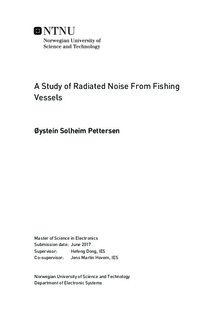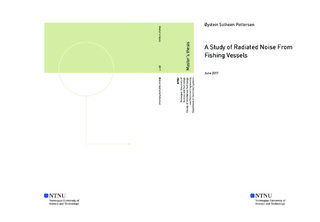| dc.description.abstract | The oceans are covering most of the earth. The noise levels in the oceans are high, even though most people are ignorant to the fact. Through the increase in anthropogenic noise in the oceans, the ambient noise level is rising. Low frequent sound can propagate over large distances and is therefore omnipresent. This is the cause of the concern that humans pollute the oceans not only with plastic and rubbish but pollute with oceanic sound emissions as well. This has, to a large extent unknown consequences for marine life.
There are several anthropogenic noise sources that contribute to the increase of the ambient sound level. The shipping industry together with seismic explorations are two of those that have the largest impact. Seismic explorations have excessive noise levels, but relative to ships, they are rare. Ships on the other hand yield lower noise levels, but are outnumbering the seismic explorations. The emitted noise can harm, disturb and confuse marine life. The literature is more focused on marine mammals, such as wales. However, fish are also affected.
This study focuses on analysis of ship noise. DNV-GL has put forward a standard related to ship noise with specific noise levels that are acceptable for different kinds of ships in different conditions. Ecoxy in collaboration with Jens Hovem have developed a measurement procedure and EcoNoise, a computer program that enables processing of the recorded files with a given structure following a procedure according to this standard. Data from several field trials of measuring fishing vessels conducted by Ecoxy AS were made available for this thesis. The acoustic data which has been processed as part of this thesis stems from these measurements.
EcoNoise, the computer program, has been the basis of the data analysis which will be presented in this thesis. The functions have been changed to find the wanted metrics used for analysis. Different components of the acoustic emissions have been studied, such as the audible range of the noise for fish radiated from the ships as well as suggesting a possible procedure to measure the directivity of the vessels.
A graphical user interface has also been developed for EcoNoise as a part of this thesis. The interface combines all the functionality of EcoNoise in an interface which is easy to use. This has been done to make the program more user friendly and make it more available for people without too much programming knowledge. This is important to enable for example the fishermen themselves to use the program while at sea.
Vibration measurements of the hull of the ferry MF Glutra have been performed. This was done as preparation for measuring the vibration of the hull of one of the fishing vessels, but these measurements were not done due to the ship's schedule. Through established formulae for calculating vibration, the vibration in plates with different characteristics was calculated. Through these simulations, it was found that the plates have resonance frequencies in the audible range for fish, and will therefore have an impact on fish. | |

